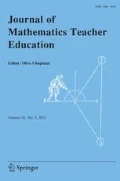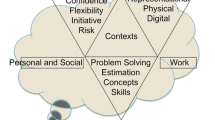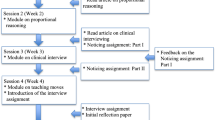Abstract
This paper describes part of an international project considering graphical construction of antiderivative functions in the secondary mathematics classroom. We use Schoenfeld’s resources, orientations, and goals (ROGs) framework to analyse the decisions made by a teacher, Adam, during a lesson on graphical antiderivatives. We present details of Adam’s ROG and see how this is related to resolution of the conflict between his competing goals and the decisions he makes. The results suggest that a beneficial professional development strategy might be to assist teachers to become more aware of their ROG and its influence on in-the-moment classroom decisions.







Similar content being viewed by others
References
Aguirre, J., & Speer, N. M. (2000). Examining the relationship between beliefs and goals in teacher practice. Journal of Mathematical Behavior, 18(3), 327–356.
Ball, D. L., & Bass, H. (2000). Interweaving content and pedagogy in teaching and learning to teach: Knowing and using mathematics. In J. Boaler (Ed.), Multiple perspectives on the teaching and learning of mathematics (pp. 93–104). Westport, CT: Ablex.
Ball, D. L., & Bass, H. (2003). Toward a practice-based theory of mathematical knowledge for teaching. In B. Davis & E. Simmt (Eds.), Proceedings of the 2002 annual meeting of the Canadian Mathematics Education Study Group (pp. 3–14). Edmonton, AB: CMESG/GDEDM.
Berry, J. S., & Nyman, M. A. (2003). Promoting students’ understanding of the calculus. Journal of Mathematical Behavior, 22, 481–497.
Duval, R. (2006). A cognitive analysis of problems of comprehension in a learning of mathematics. Educational Studies in Mathematics, 61, 103–131.
Haciomeroglu, E. S., Aspinwall, L., & Presmeg, N. (2009). The role of reversibility in the learning of the calculus derivative and antiderivative graphs. In S. L. Swars, D. W. Stinson, & S. Lemons-Smith (Eds.), Proceedings of the 31st annual meeting of the North American Chapter of The International Group for the Psychology of Mathematics Education. Atlanta, Georgia: Georgia State University.
Hill, H., & Ball, D. L. (2004). Learning mathematics for teaching: Results from California’s mathematics professional development institutes. Journal for Research in Mathematics Education, 35(5), 330–351.
Jaworski, B. (2006). Theory and practice in mathematics teaching development: Critical inquiry as a mode of learning in teaching. Journal of Mathematics Teacher Education, 9, 187–211. doi:10.1007/s10857-005-1223-z.
Liljedahl, P. (2010). Noticing rapid and profound mathematics teacher change. Journal of Mathematics Teacher Education, 13, 411–423.
O’Neill, G., & McMahon, T. (2005). Student-centred learning: What does it mean for students and lecturers? In G. O’Neill, S. Moore, & B. McMullin (Eds.), Emerging issues in the practice of university learning and teaching (pp. 27–36). Dublin: All Ireland Society for Higher Education (AISHE).
Park, K., & Travers, K. J. (1996). A comparative study of a computer-based and a standard college first-year calculus course. In J. Kaput, A. H. Schoenfeld, & E. Dubinsky (Eds.), CBMS issues in mathematics education, research in collegiate mathematics education II (Vol. 6, pp. 155–176). Providence, Rhode Island: American Mathematical Society.
Paterson, J., Thomas, M. O. J., & Taylor, S. (2011). Decisions, decisions, decisions: What determines the path taken in lectures? International Journal of Mathematical Education in Science and Technology, 42(7), 985–996.
Potari, D., Sakonidis, H., Chatzigoula, R., & Manaridistake, A. (2010). Teachers’ and researchers’ collaboration in analyzing mathematics teaching: A context for professional reflection and development. Journal of Mathematics Teacher Education, 13, 473–485.
Rasmussen, C. (2001). New directions in differential equations: A framework for interpreting students’ understandings and difficulties. Journal of Mathematical Behavior, 20, 1–33.
Sarrazy, B. (2002). Effects of variability on responsiveness to the didactic contract in problem-solving among pupils of 9–10 years. European Journal of Psychology of Education, 6(XVII), 321–341.
Schoenfeld, A. H. (2002). A highly interactive discourse structure. In J. Brophy (Ed.), Social constructivist teaching: Its affordances and constraints (Vol. 9 of the series advances in research on teaching (pp. 131–169). Amsterdam: JAI Press.
Schoenfeld, A. H. (2007). A theory of teaching and its applications. In commemoration of Guenter Toerner’s 60th Birthday. The Montana Mathematics Enthusiast, Monograph, 3, 33–38.
Schoenfeld, A. H. (2008). On modeling teachers’ in-the-moment decision-making. In A. H. Schoenfeld (Ed.), A study of teaching: Multiple lenses, multiple views (Journal for Research in Mathematics Education Monograph No. 14, pp. 45–96). Reston, VA: National Council of Teachers of Mathematics.
Schoenfeld, A. H. (2011). How we think. A theory of goal-oriented decision making and its educational applications. New York: Routledge.
Shulman, L. (1986). Those who understand: Knowledge growth in teaching. Educational Researcher, 15(2), 4–14.
Sowder, J. T. (2007). The mathematical education and development of teachers. In F. K. Lester (Ed.), Second handbook of research on mathematics teaching and learning. Charlotte, NC: Information Age Publishing.
Speer, N. M. (2008). Connecting beliefs and practices: A fine-grained analysis of a college mathematics teacher’s collections of beliefs and their relationship to his instructional practices. Cognition and Instruction, 26(2), 218–267.
Sullivan, P., & Wood, T. (Eds.) (2008). Knowledge and beliefs in mathematics teaching and teaching development. The International Handbook of Mathematics Teacher Education, Vol. I. Rotterdam, Taipei: Sense Publishers.
Tall, D. O. (2004). Building theories: The three worlds of mathematics. For the Learning of Mathematics, 24(1), 29–32.
Tall, D. O. (2008). The transition to formal thinking in mathematics. Mathematics Education Research Journal, 20(2), 5–24.
Tall, D. O. (2010). A sensible approach to the calculus. Plenary paper at The National and International Meeting on the Teaching of Calculus, 23–25th September 2010, Puebla, Mexico. Available online at http://www.warwick.ac.uk/staff/David.Tall/pdfs/dot2010a-sensible-calculus.pdf.
Thompson, P. W. (1993). Students, functions, and the undergraduate curriculum. Presentation to the Annual Joint Meeting of AMS/MAA. January, Contemporary Mathematics, (publ. American Mathematical Society).
Ticha, M., & Hospesova, A. (2006). Qualified pedagogical reflection as a way to improve mathematics education. Journal of Mathematics Teacher Education, 9, 129–156.
Törner, G., Rolke, K., Rösken, B., & Sririman, B. (2010). Understanding a teacher’s actions in the classroom by applying Schoenfeld’s theory teaching-in-context: Reflecting on goals and beliefs. In B. Sriraman & L. English (Eds.), Theories of mathematics education, advances in mathematics education (pp. 401–420). Berlin: Springer.
Wilkins, J. L. M. (2008). The relationship among elementary teachers’ content knowledge, attitudes, beliefs, and practices. Journal of Mathematics Teacher Education, 11, 139–164.
Yoon, C., Dreyfus, T., & Thomas, M. O. J. (2010). How high is the tramping track? Mathematising and applying in a calculus model-eliciting activity. Mathematics Education Research Journal, 22(2), 141–157.
Yoon, C., Thomas, M. O. J., & Dreyfus, T. (2011). Gestures and insight in advanced mathematical thinking. International Journal on Mathematics Education in Science and Technology, 42(7), 891–902.
Acknowledgments
We wish to acknowledge Tessa Miskell for her transcription and video annotation.
Author information
Authors and Affiliations
Corresponding author
Rights and permissions
About this article
Cite this article
Thomas, M., Yoon, C. The impact of conflicting goals on mathematical teaching decisions. J Math Teacher Educ 17, 227–243 (2014). https://doi.org/10.1007/s10857-013-9241-8
Published:
Issue Date:
DOI: https://doi.org/10.1007/s10857-013-9241-8




